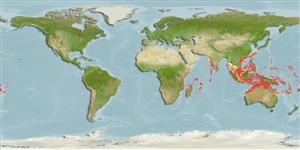Issue
Type locality: Mauritius.
Environment: milieu / climate zone / depth range / distribution range
بوم شناسي
دريايي وابسته به آب سنگ; تغييرات عمق 4 - 200 m (Ref. 5222), usually 12 - 90 m (Ref. 37816). Tropical; 29°N - 26°S, 38°E - 171°W (Ref. 5222)
Indo-Pacific: east coast of Africa (Zanzibar and Mafia Island, Tanzania) to Samoa, north to Ryukyu Islands, south to Queensland, Australia.
Length at first maturity / Size / Weight / سن
Maturity: Lm ?, range 67 - ? cm
Max length : 65.0 cm TL جنس نر / بدون خواص جنسي; (Ref. 48635)
خارهاي باله پشتي (کل) : 9; شعاع نرم باله پشتي (کل) : 14; خارهاي باله مخرجي: 3; شعاع نرم باله مخرجي: 8. This species is distinguished by the following characters: body oblong, its depth 2.8-3.5 in SL; preopercle rounded, finely serrate, the lower edge fleshy; opercle with 3 flat spines; upper edge of operculum almost straight; rear nostrils not much bigger than anterior nostrils; front of jaws with a pair of large canine teeth; 1-3 large canines at midside of lower jaw; gill rakers of first gill arch 7-9 + 13-16 = 20-25 (including 4 to 7 rudiments on each limb); caudal fin lunate, the upper and lower lobes produced, about twice length of middle rays; pectoral-fin rays 17-19; lateral-line scales 66-76, in series 109-127. Colour of head, body and fins generally reddish with small irregular pale blue to pink spots; 3-4 diffuse pale saddle on back; broad caudal fin usually dusky, with narrow white posterior margin or edge (yellow in V. louti); juveniles similar in colour to adults, but with relatively fewer and larger pale blue or pink spots (Ref. 39231, 89707, 90102).
A generally uncommon species that inhabits seaward reefs (Ref. 9710). Juveniles inshore on algae and soft coral reefs, usually swimming well above the substrate, looking much like a basslet (Ref. 48635). Solitary (Ref 90102) or found in small groups (Ref. 11888). Feeds on fishes. Of little interest to fisheries, because of its small size and rarity, but flesh is excellent.
Caught with handline, traps, and spear (Ref. 39231).
Life cycle and mating behavior
Maturities | تولید مثل | Spawnings | Egg(s) | Fecundities | توزاد ( لارو)
Heemstra, P.C. and J.E. Randall, 1993. FAO Species Catalogue. Vol. 16. Groupers of the world (family Serranidae, subfamily Epinephelinae). An annotated and illustrated catalogue of the grouper, rockcod, hind, coral grouper and lyretail species known to date. Rome: FAO. FAO Fish. Synop. 125(16):382 p. (Ref. 5222)
وضعيت در فهرست قرمز IUCN (Ref. 130435)
خطر برای انسان ها
Harmless
استفاده انسانی
ماهي گيري – شيلات: معاش ماهیگیری
ابزارها
گزارش های ويژه
بارگيری XML
منابع اينترنتي
Estimates based on models
Preferred temperature (Ref.
123201): 23.9 - 28.9, mean 27.7 °C (based on 1802 cells).
Phylogenetic diversity index (Ref.
82804): PD
50 = 0.7500 [Uniqueness, from 0.5 = low to 2.0 = high].
Bayesian length-weight: a=0.01349 (0.00851 - 0.02138), b=3.07 (2.94 - 3.20), in cm total length, based on LWR estimates for this species & (Sub)family-body (Ref.
93245).
Trophic level (Ref.
69278): 4.5 ±0.80 se; based on food items.
جهندگی (Ref.
120179): پايين ، كم, كمينه زمان لازم براي دو برابر شدن جمعيت 5/4 – 14 سال (Preliminary K or Fecundity.).
Fishing Vulnerability (Ref.
59153): Moderate to high vulnerability (46 of 100).
Nutrients (Ref.
124155): Calcium = 34.1 [19.7, 61.7] mg/100g; Iron = 0.611 [0.316, 1.027] mg/100g; Protein = 18.9 [17.0, 20.6] %; Omega3 = 0.177 [0.114, 0.284] g/100g; Selenium = 49.3 [28.0, 93.9] μg/100g; VitaminA = 83.1 [29.8, 278.9] μg/100g; Zinc = 0.708 [0.473, 1.044] mg/100g (wet weight);
